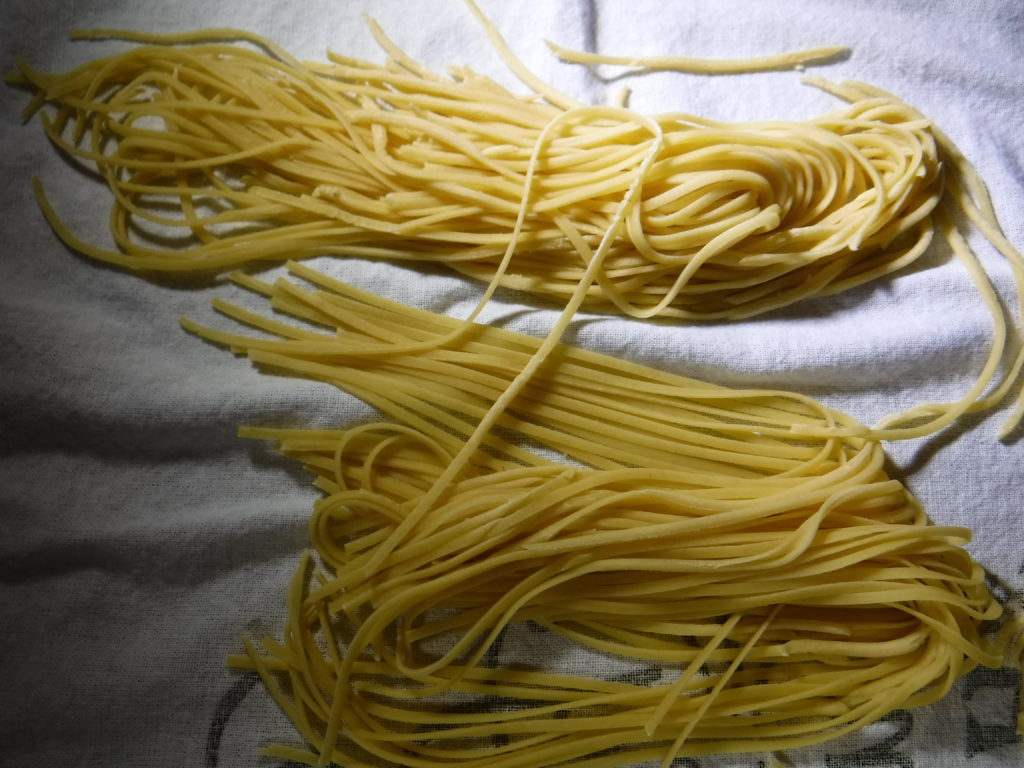
This is the version of fresh pasta popular in the Emilia-Romagna region of Italy, and consists only of eggs and flour. With such a simple recipe, this is all about technique. I am following here the instructions of Guiliano Hazan on Craftsy. I used some Italian 00 flour, since I had some in the pantry, but Guiliano recommends American all-purpose flour. I used an Atlas pasta machine, anchored to the island in my kitchen.
My first batch was a disaster since I accidentally omitted the step of letting the thin pasta sheets dry a bit before cutting them. The result was that the cut pasta stuck together. This might have been solvable if I had cooked the pasta immediately, but this kind of fresh pasta can be stored unrefrigerated for an extended period of time, so I made on one day the pasta I was going to cook the next day. By that next day, the pasta had thoroughly stuck together and did not release in the boiling water. Oh well.
On the second try, I not only allowed the sheets to dry, but I teased apart the individual strands of pasta, and I cooked them later the same day. There was absolutely no sticking. It was al dente in about 3 minutes of cooking in boiling salted water, and made 4 generous servings.
11.5 oz. all-purpose flour (or Italian 00 flour)
3 large eggs at room temperature.
On a large wooden or plastic board, heap the flour in the center, and then form a large cavity in the center, so that the flour looks like a large volcano. Break the eggs and put them in the cavity in the center of the flour volcano. Scramble them with a fork. Slowly work in some of the flour from the walls of the volcano with a fork until the egg-flour mixture is no longer runny. At this stage, move about ¼ cup of flour to the side of the board so that it can be used only if necessary. (It is easier to add flour if the dough is too sticky, and very hard to remove any flour if the dough is too stiff.)
With your hands and a dough scrapper, mix together the remaining flour and the egg-flour mixture to form a dough. Once a dough forms, begin to knead it until it becomes very smooth, about 5 minutes. Add flour from the reserve if necessary. When done, the dough should not be at all sticky, either on the outside nor the inside. When smooth, wrap the dough tightly in plastic wrap and allow it to rest for 20 minutes to 3 hours at room termperature.
After the dough has rested, there may be some moisture which has wicked out to the surface. If so, knead the dough a few times to redistribute it back into the dough. Cut the dough into 3 even pieces. Place a large kitchen towel on the counter. Form the first piece of dough into a circle about 5 inches in diameter. Pass it through the pasta machine at its widest setting. Fold the rolled pasta into thirds like a letter, and pass it through the rollers a second time. Fold it in half and pass it a third time through the rollers on the wide side. Place the rolled sheet on a towel while the other two pieces of dough are run through the rollers three times.
Set the pasta machine on its second widest setting and pass each of the sheets through it one at a time. After each sheet has run through lay it on the kitchen towel while rolling the other sheets. Set the machine on its third widest setting, and roll the sheets again one by one. Continue until you have rolled it through 5 settings. If the sheets start to get longer than about 18 inches, cut them in half so that the noodles will not be too long. After all the pieces have been rolled out, let them dry on the towel for 20-30 minutes, flipping them every 5-10 minutes. The objective is for them to be leathery, but not so dry that they will crumble and not pass through the cutter.
Cut the noodles with a cutting attachment (which is what I did) or by rolling them loosely up and cutting them with a knife. Lay the cut strands on the cloth to continue drying, separating any that seem to be sticking together. At this point the pasta can be cooked later on the same day, or can be stored in a dry dust-free place for up to several months. If storing long term, ensure that it is fully dry before putting it into an enclosed container.

